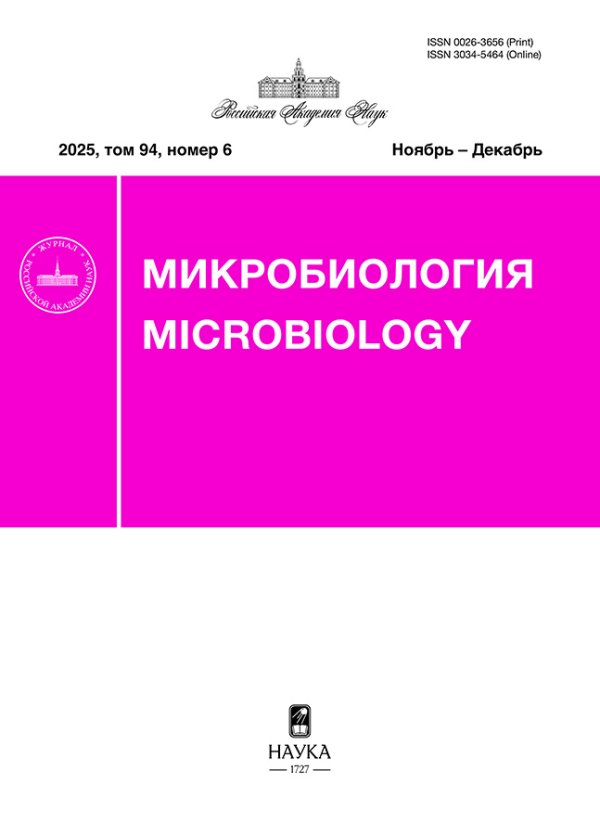Molecular Genetic and Functional Analysis of the Genes Encoding Alkane 1‑Monoozygenase Synthesis in Members of the Genus Rhodococcus
- Authors: Bulyarevich A.A.1, Gurinovich A.S.1, Filonov A.E.2, Titok M.A.1
-
Affiliations:
- Belarusian State University
- Skryabin Institute of Biochemistry and Physiology of Microorganisms
- Issue: Vol 92, No 2 (2023)
- Pages: 204-218
- Section: EXPERIMENTAL ARTICLES
- URL: https://journals.rcsi.science/0026-3656/article/view/138167
- DOI: https://doi.org/10.31857/S0026365622600687
- EDN: https://elibrary.ru/ATIXSO
- ID: 138167
Cite item
Full Text
Abstract
Abstract—Organization and localization of the alkB genes and of alkane 1-monooxygenases they encode in members of the genus Rhodococcus was investigated. All members of a phylogenetic group were found to possess specific types of the alkB genes (alkB1-type in the operons containing rubredoxin-coding genes, rubredoxin reductase, and a regulatory protein and/or alkB2-type in the operons lacking the rubredoxin-reductase-coding gene, and supplementary, separately located determinants of the alkB3−alkB8 type). The alkB1-type genes were present in the chromosomes of bacteria of groups B1 (R. aetherivorans, R. ruber), С (R. opacus, R. jostii, R. wratislaviensis, R. koreensis), D (R. erythropolis, R. qingshengii), G (R. triatomae), and E (R. fascians). The alkB2-type genes occurred in strictly specified loci of the chromosomes of members of the phylogenetic groups А (R. hoagii/R. equi), В2 (R. coprophilus, R. pyridinivorans, R. rhodochrous), and D (R. erythropolis, R. qingshengii). The separately located alkB3−alkB5 were revealed in the chromosomes of members of the D group D (alkB5 was found only in R. qingshengii), the alkB6 genes occurred in members of the groups B1 and В2, and alkB7−alkB8 were present in members of group Е. The proteins coded by the genes alkB1 and alkB2 belonged to three phylogenetic groups. The first one comprised AlkB1-type proteins of members of groups В1 and С and the AlkB2-type proteins of members of groups D and A. The second one was represented by AlkB2-type proteins of bacteria of group В2. The third group comprised AlkB1-type proteins of members of groups G and D. Alkane 1-monooxygenases encoded by separately localized genes alkB3−alkB8 were represented by three phylogenetic lineages: AlkB3−AlkB5, AlkB6, and AlkB7 and AlkB8. In the genome of R. pyridinivorans 5Ар, the genes alkB2 and alkB6 characteristic of group В1 were revealed. This determinants were shown to be required for biosurfactant synthesis. Emulsifying activity of the mutant with impaired alkB2 gene at 28 and 42°С was 16 and 3 times lower, respectively, while the amount of trehalose-containing surfactants decreased 7 and 3 times, respectively. Independent on the cultivation temperature, the mutant with impaired alkB6 gene exhibited 1.2 times lower emulsifying activity and more than twofold lower decrease of the synthesis of trehalose-containing surfactants. These results indicated the key role of alkB2 in biosurfactant synthesis at different cultivation temperatures. The role of alkB6 increased at 42°С, probably due to its elevated transcriptional activity.
Keywords
About the authors
A. A. Bulyarevich
Belarusian State University
Email: ma_titok@bsu.by
Belarus, 220030, Minsk
A. S. Gurinovich
Belarusian State University
Email: ma_titok@bsu.by
Belarus, 220030, Minsk
A. E. Filonov
Skryabin Institute of Biochemistry and Physiology of Microorganisms
Email: ma_titok@bsu.by
Russia, 142290, Pushchino
M. A. Titok
Belarusian State University
Author for correspondence.
Email: ma_titok@bsu.by
Belarus, 220030, Minsk
References
- Ратникова М.С., Титок М.А. Молекулярно-генетические маркеры для идентификации бактерий Rhodococcus erythropolis и Rhodococcus qingshengii // Микробиология. 2020. Т. 89. С. 444–452.
- Ratnikova M.S., Titok M.A. Molecular genetic markers for identification of Rhodococcus erythropolis and Rhodococcus qingshengii // Microbiology (Moscow). 2020. V. 89. P. 435‒442.
- Beilen J.B. van, Funhoff E.G. Alkane hydroxylases involved in microbial alkane degradation // Appl. Microbiol. Biotechnol. 2007. V. 74. P. 13–21.
- Beilen J.B. van, Neuenschwander M., Smits T.H.M., Roth C., Balada S.B., Witholt B. Rubredoxins involved in alkane oxidation // J. Bacteriol. 2002. V. 184. P. 1722–1732.
- Ceniceros A., Dijkhuizen L., Petrusma M., Medema M.H. Genome-based exploration of the specialized metabolic capacities of the genus Rhodococcus // BMC Genomics. 2017. V. 18. P. 593.
- Chénier M.R., Beaumier D., Roy R., Driscoll B.T., Lawrence J.R., Greer C.W. Impact of seasonal variations and nutrient inputs on nitrogen cycling and degradation of hexadecane by replicated river biofilms // Appl. Environ. Microbiol. 2003. V. 69. P. 5170–5177.
- Cooper D.G., Goldenberg B.G. Surface-Active agents from two Bacillus species // Appl. Environ. Microbiol. 1987. V. 53. P. 224–229.
- DuBois Michel., Gilles K.A., Hamilton J.K., Rebers P.A., Smith Fred. Colorimetric method for determination of sugars and related substances // Anal. Chem. 1956. V. 28. P. 350–356.
- Eras-Muñoz E., Farré A., Sánchez A., Font X., Gea T. Microbial biosurfactants: a review of recent environmental applications // Bioengineered. 2022. V. 13. P. 12365–12391.
- Geize R. van der, Hessels G.I., Gerwen R. van, Meijden P. van der, Dijkhuizen L. Unmarked gene deletion mutagenesis of kstD, encoding 3-ketosteroid Delta1-dehydrogenase, in Rhodococcus erythropolis SQ1 using sacB as counter-selectable marker // FEMS Microbiol. Lett. 2001. V. 205. P. 197–202.
- Gürtler V., Mayall B.C., Seviour R. Can whole genome analysis refine the taxonomy of the genus Rhodococcus? // FEMS Microbiol. Rev. 2004. V. 28. P. 377–403.
- Inaba T., Tokumoto Y., Miyazaki Y., Inoue N., Maseda H., Nakajima-Kambe T., Uchiyama H., Nomura N. Analysis of genes for succinoyl trehalose lipid production and increasing production in Rhodococcus sp. strain SD-74 // Appl. Environ. Microbiol. 2013. V. 79. P. 7082–7090.
- Kim D., Choi K.Y., Yoo M., Zylstra G.J., Kim E. Biotechnological potential of Rhodococcus biodegradative pathways // Microbiol. Biotechnol. 2018. V. 28. P. 1037–1051.
- Kügler J.H., Le Roes-Hill M., Syldatk C., Hausmann R. Surfactants tailored by the class Actinobacteria // Front. Microbiol. 2015. V. 6. Art. 212.
- Kumar S., Stecher G., Tamura K. MEGA7: Molecular evolutionary genetics analysis Version 7.0 for Bigger Datasets // Mol. Biol. Evol. 2016. V. 33. P. 1870–1874.
- Kuyukina M.S., Ivshina I.B. Rhodococcus biosurfactants: biosynthesis, properties, and potential applications // Biology of Rhodococcus, Microbiology Monographs / Ed. Alvarez H.M. Berlin, Heidelberg: Springer, 2010. P. 291–313.
- Kuyukina M.S., Ivshina I.B., Baeva T.A., Kochina O.A., Gein S.V., Chereshnev V.A. Trehalolipid biosurfactants from nonpathogenic Rhodococcus actinobacteria with diverse immunomodulatory activities // Biotechnol. 2015. V. 32. P. 559–568.
- Kuyukina M.S., Ivshina I.B., Philp J.C., Christofi N., Dunbar S.A., Ritchkova M.I. Recovery of Rhodococcus biosurfactants using methyl tertiary-butyl ether extraction // J. Microbiol. Methods. 2001. V. 46. P. 149–156.
- Larkin M.J., Kulakov L.A., Allen C.C.R. Biodegradation and Rhodococcus – masters of catabolic versatility // Curr. Opin. Biotechnol. 2005. V. 16. P. 282–290.
- Liu H., Xu J., Liang R., Liu J. Characterization of the medium- and long-chain n-alkanes degrading Pseudomonas aeruginosa strain SJTD-1 and its alkane hydroxylase genes // PLoS One. 2014. V. 9. P. e105506.
- Luong T.M., Ponamoreva O.N., Nechaeva I.A., Petrikov K.V., Delegan Ya.A., Surin A.K., Linklater D., Filonov A.E. Characterization of biosurfactants produced by the oil-degrading bacterium Rhodococcus erythropolis S67 at low temperature // J. Microbiol. Biotechnol. 2018. V. 34. P. 20.
- Majidzadeh M., Fatahi-Bafghi M. Current taxonomy of Rhodococcus species and their role in infections // Eur. J. Clin. Microbiol. Infect. Dis. 2018. V. 37. P. 2045–2062.
- Martínková L., Uhnáková B., Pátek M., Nesvera J., Kren V. Biodegradation potential of the genus Rhodococcus // Environ. Int. 2009. V. 35. P. 162–177.
- Metcalf W.W., Jiang W., Wanner B.L. Use of the rep technique for allele replacement to construct new Escherichia coli hosts for maintenance of R6K gamma origin plasmids at different copy numbers // Gene. 1994. V. 138. P. 1–7.
- Mutalik S.R., Vaidya B.K., Joshi R.M., Desai K.M., Nene S.N. Use of response surface optimization for the production of biosurfactant from Rhodococcus spp. MTCC 2574 // Bioresour. Technol. 2008. V. 99. P. 7875–7880.
- Nie Y., Chi C.-Q., Fang H., Liang J.-L., Lu S.-L., Lai G.-L., Tang Y.-Q., Wu X.-L. Diverse alkane hydroxylase genes in microorganisms and environments // Sci. Rep. 2014. V. 4. P. 4968.
- Pfaffl M.W. A new mathematical model for relative quantification in real-time RT-PCR // Nucleic Acids Res. 2001. V. 29. P. e45.
- Pirog T.P., Shevchuk T.A., Klimenko I.A. Intensification of surfactant synthesis in Rhodococcus erythropolis EK-1 cultivated on hexadecane // Appl. Biochem. Microbiol. 2010. V. 46. P. 651–658.
- Retamal-Morales G., Heine T., Tischler J.S., Erler B., Gröning J.A.D., Kaschabek S.R., Schlömann M., Levicán G., Tischler D. Draft genome sequence of Rhodococcus erythropolis B7g, a biosurfactant producing actinobacterium // J. Biotechnol. 2018. V. 280. P. 38–41.
- Riele H. te, Michel B., Ehrlich S.D. Single-stranded plasmid DNA in Bacillus subtilis and Staphylococcus aureus // Proc. Natl. Acad. Sci. USA. 1986. V. 83. P. 2541–2545.
- Rojo F. Degradation of alkanes by bacteria // Environ. Microbiol. 2009. V. 11. P. 2477–2490.
- Rosa C.F.C. da, Freire D.M.G., Ferraz H.C. Biosurfactant microfoam: application in the removal of pollutants from soil // J. Environ. Chem. Engineer. 2015. V. 3. P. 89–94.
- Sangal V., Goodfellow M., Jones A.L., Schwalbe E.C., Blom J., Hoskisson P.A., Sutcliffe I.C. Next-generation systematics: an innovative approach to resolve the structure of complex prokaryotic taxa // Sci. Rep. 2016. V. 6. Art. 38392.
- Schäfer A., Tauch A., Jäger W., Kalinowski J., Thierbach G., Pühler A. Small mobilizable multi-purpose cloning vectors derived from the Escherichia coli plasmids pK18 and pK19: selection of defined deletions in the chromosome of Corynebacterium glutamicum // Gene. 1994. V. 145. P. 69–73.
- Schirmer A., Rude M.A., Li X., Popova E., Cardayre S.B. del Microbial biosynthesis of alkanes // Science. 2010. V. 329. P. 559–562.
- Shanklin J., Whittle E., Fox B.G. Eight histidine residues are catalytically essential in a membrane-associated iron enzyme, stearoyl-CoA desaturase, and are conserved in alkane hydroxylase and xylene monooxygenase // Biochemistry. 1994. V. 33. P. 12787–12794.
- Smits T.H., Röthlisberger M., Witholt B., Beilen J.B. van Molecular screening for alkane hydroxylase genes in Gram-negative and Gram-positive strains // Environ. Microbiol. 1999. V. 1. P. 307–317.
- Táncsics A., Benedek T., Szoboszlay S., Veres P.G., Farkas M., Máthé I., Márialigeti K., Kukolya J., Lányi S., Kriszt B. The detection and phylogenetic analysis of the alkane 1-monooxygenase gene of members of the genus Rhodococcus // Syst. Appl. Microbiol. 2015. V. 38. P. 1–7.
- Uchida Y., Tsuchiya R., Chino M., Hirano J., Tabuchi T. Extracellular accumulation of mono- and di-succinoyl trehalose lipids by a strain of Rhodococcus erythropolis grown on n-alkanes // Agricult. Biol. Chem. 1989. V. 53. P. 757–763.
- Uzoigwe C., Burgess J.G., Ennis C.J., Rahman P.K.S.M. Bioemulsifiers are not biosurfactants and require different screening approaches // Front. Microbiol. 2015. V. 6. Art. 245.
- Whyte L.G., Smits T.H.M., Labbé D., Witholt B., Greer C.W., van Beilen J.B. Gene cloning and characterization of multiple alkane hydroxylase systems in Rhodococcus strains Q15 and NRRL B-16531 // Appl. Environ Microbiol. 2002. V. 68. P. 5933–5942.
- Williams S.C., Austin R.N. An overview of the electron transfer proteins that activate alkane monooxygenase (AlkB) // Front. Microbiol. 2022. V. 13. Art. 845551.
- Wood E.J. Molecular Cloning. A Laboratory Manual Eds. Fritsch E.F., Sambrook J. New York: Cold Spring Harbor Laboratory, 1982. 545 р. ISBN 0-87969-136-0 // Biochemical Education. 1983. V. 11. № 2. P. 82–82.
Supplementary files

















